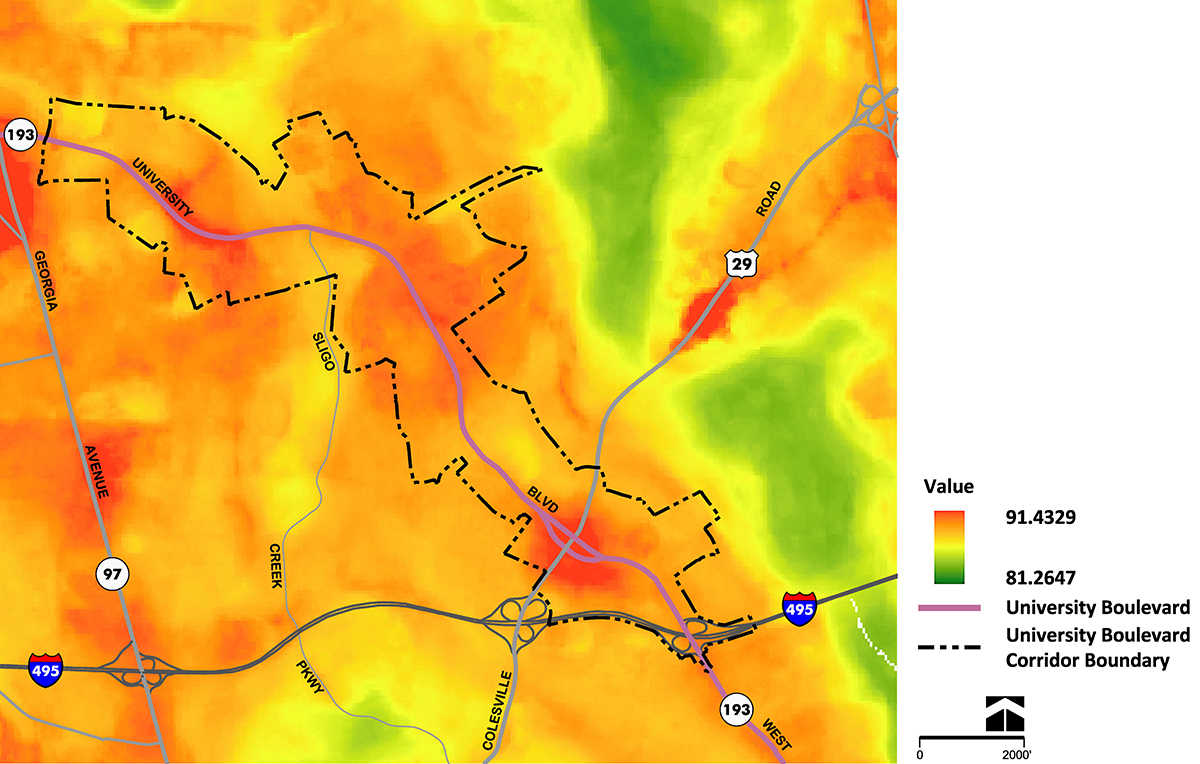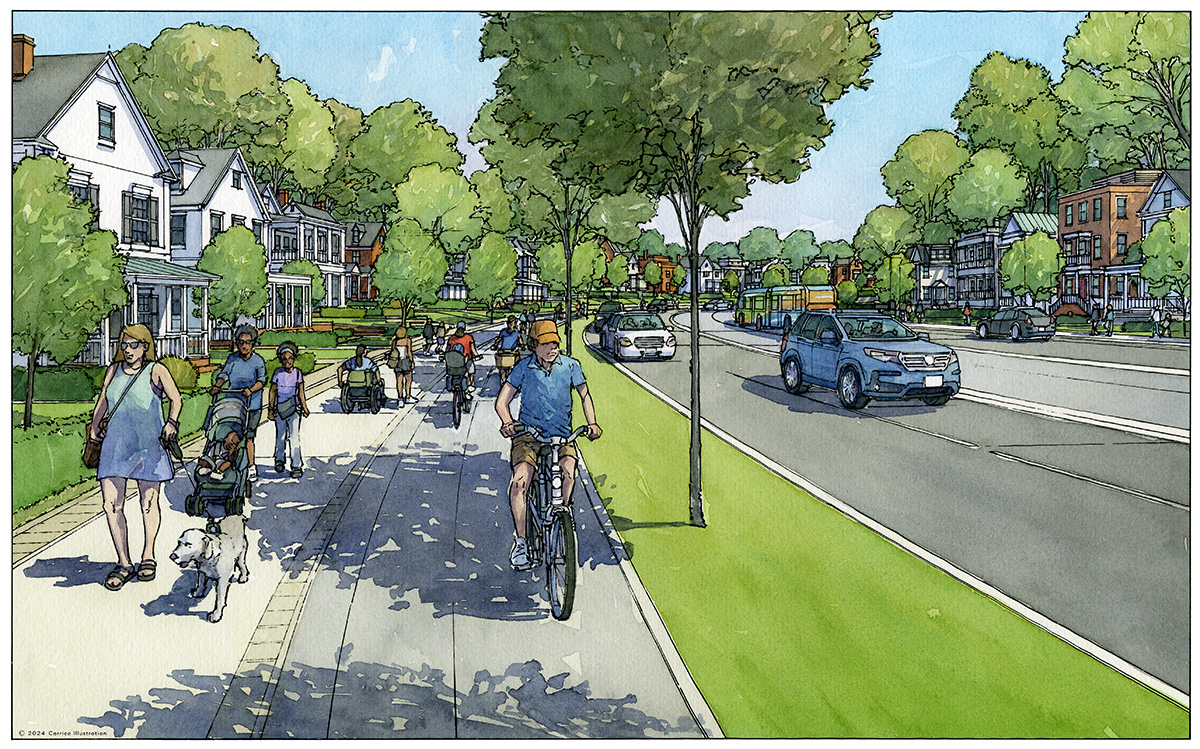By Montgomery Planning Staff
Residents who walk, ride bikes, and wait for buses along busy roads in the Washington, DC region more often feel the unhealthy effects of traffic-related air pollution and blistering summer days.
Asphalt roads and parking lots, as well as concrete sidewalks, absorb the sun, creating “heat islands” with higher temperatures. A 2022 heat mapping study of Montgomery County found that these areas reached up to ten degrees hotter than rural areas.

Montgomery Planning’s 2022 heat mapping study reveals red and dark orange “heat islands” along University Boulevard and other corridors.
As Montgomery Planning Environmental Planner Steve Findley explained: “Obviously, anybody who is outside a vehicle—anybody who is walking, biking or rolling along the corridor or waiting for transit—is going to be exposed to these heat island impacts.”
This seemingly complex problem has a simple solution: Trees.
The ‘cool corridor’ concept
By significantly expanding tree canopy along major transportation corridors, we can make those areas and surrounding communities cooler, greener, healthier, and more resilient. With more trees, they become “cool corridors.”
The University Boulevard Corridor Plan covering a 3.5-mile stretch of University Boulevard between the Capital Beltway (I-495) and Amherst Avenue (just east of Georgia Avenue) is the first to include “cool corridor” recommendations. These ideas will be explored for other major transportation corridors when they are studied for potential improvements, especially because these are areas that have the infrastructure to accommodate future development.
A “cool corridor” would have ample shade for people waiting at bus stops, as well as for children walking to school. It also would have more trees in parking lots, both for shade and to help absorb and control stormwater that can cause flooding and send warm, dirty water into nearby streams.

This rendering of what a section of Randolph Road might look like in the future shows a consistent tree canopy along the roadway, providing shade for pedestrian and bicyclists. This image is from Montgomery Planning’s 2025 Glenmont Corridors Opportunity Study.
As we feel the heat more in hotter months due to climate change, the shade from additional trees can create a healthier community. According to the National Weather Service, heat sickens and kills more people than any other weather-related event. In communities such as along University Boulevard, with numerous schools and other community destinations, simple improvements like trees can have a profound effect.
In addition to providing shade, trees help clean the air because leaves and branches “catch” the fine particulate matter from vehicle exhaust, according to the National Park Service. These tiny, toxic particles that can get into people’s lungs and blood streams have been linked to asthma, heart disease, diabetes, and cancer.
Improving health and safety
Beyond health benefits, roadside trees and shrubs can provide a green buffer between cars and buses and people walking or bicycling alongside, making it safer, more comfortable and pleasant to forgo driving. Of course, the more people who skip the drive, the better it is for the environment.
It’s part of how we’re working to remake these corridors into vibrant, sustainable communities. More trees would reflect priorities in the county’s Climate Action Plan and the environmental priorities in our General Plan, called Thrive Montgomery 2050.
Moreover, “cool corridors” would help the county reach its Vision Zero goal to eliminate fatal and serious-injury crashes by prioritizing pedestrians’ and cyclists’ safety in street designs. Roadside trees create a “perception of friction” that naturally causes drivers to slow down, Findley said.
“It’s almost like a Vision Double-Zero,” Findley said. “We’re eliminating and minimizing severe traffic injuries and deaths from vehicles but also minimizing sickness and injuries from the environmental impacts of the roadways themselves.” Achieving both goals also supports the County’s equity agenda.
Planting trees along the University Boulevard corridor will require creating road designs that provide adequate soil for trees to grow and choosing native tree species that can deal with the challenges of roadway environments. Investing in road designs to accommodate trees is as important as designing roads for traffic safety. Designing for trees and safety will pay dividends in improved health and well-being for those traveling through the corridor, as well as those who live in the larger Plan area.
Findley also points out, the benefits of a “cool corridor” along busy roads such as University Boulevard would reach into surrounding communities, just as heat islands raise temperatures far beyond roads today.
“Planting shade trees along University Boulevard,” Findley said, “will improve the conditions in the whole neighborhood.”
The University Boulevard Corridor Plan’s environmental recommendations are one part of the picture to improve the quality of life along this important roadway. The plan also suggests ways to make all modes of transportation safer and create more housing options.
You can read more about our recommendations and other aspects of the University Boulevard Corridor Plan in our Public Hearing draft. The Montgomery County Planning Board recently held a public hearing on the draft and will refine it during work sessions this spring before sending it to the County Council for consideration this summer. Sign up for email updates on the plan.
Eva Santorini
THANK YOU!
I really like the idea of cooling corridors! More trees, more grass or native ground covers, more permeable materials, more rain gardens!
Soon you can begin research on planting milkweed for monarchs along our highways or at least native pollinator plants!
Thank you – I really appreciate your bold and fearless actions!